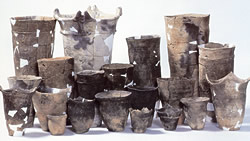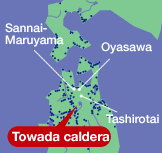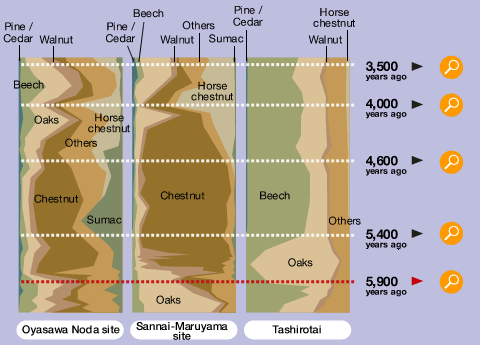Research
The new culture created by changes in the land

Photo: Aomori Prefecture Historical Materials Editing Room
As many as 10 types of bucket-type earthenware were excavated from the Sannai-Maruyama site, which showed no interruption from the lower level bucket types of the nearly Jomon period to the upper level bucket types from the middle period. These designs were succeeded by the Enokibayashi types and the Saibana types. Then the Daigi 10 types of earthenware ended. The cultures can be differentiated by the types of earthenware produced in a bucket shape, and the cultures that have this series of earthenware types are called the bucket-type earthenware culture.
The large settlement at the Sannai-Maruyama site thrived for 1,900 years, from the middle of the early Jomon period to the end of the intermediate period. Many types of earthenware were discovered at the site, which provide hints to the changes in the eras through the bucket-shaped earthenware, and the expansion of its territory. The archaeological research into the excavated items in Aomori Prefecture that total roughly 20 years in the aggregate, the natural science surveys of plant remains, including at the site and the nearby soil layers, and the accurate dating enabled scientists to unravel the connection between the ecology and the daily life and culture of the people. The sudden emergence of the bucket-shaped earthenware culture seems to have begun with the massive eruption of the Towada caldera. A pollen analysis in the soil layers reveals that a chestnut forest was maintained there immediately thereafter. After the disaster, several small and diverse settlements banded together and devised ways to survive in the radically altered ecological system. They likely created a new culture that included chestnut cultivation. The chestnut pollen in the soil decreases with the waning of the bucket-shaped earthenware culture, and there is an increase in horse chestnut pollen suitable for the cooler climate, at the same time the Daigi type earthenware culture to the south moved north. The ecology, including the human inhabitants, reached equilibrium for the next several thousand years. This was destroyed by a sudden natural disaster. The actual examples of what was newly created after that are fascinating. Dr. Tsuji is working to create a comprehensive portrait of the people living as part of that ecological system, using the large eruption as an experiment.

A comparison was made of the changes in the vegetation at the Oyasawa Noda site, which has traces of an eruption (early Jomon period) and Tashirotai at Mt. Hakkoda with information from Sannai-Maruyama to elucidate the relationship with cultural changes and with the ecology.
 denotes the sites where bucket-type earthenware was excavated.
denotes the sites where bucket-type earthenware was excavated.

Born in Shiga Prefecture in 1952, Dr. Tsuji graduated from Nihon University's College of Arts and Sciences. He later was awarded a doctorate in science. He has taught at the Osaka City University School of Science and served as an associate professor and professor at the National Museum of Japanese History. Today he is a professor at the University of Tokyo's Graduate School of Frontier Sciences and a visiting professor at the National Museum of Japanese History.
- Dialogue:The starting point nurtured by the community
Kenichiro Ohara / Keiko Nakamura - Research01:The cell walls of Trebouxiophyceae generate a diversity of cellular division
Maki Yamamoto / Shigeyuki Kawano - Research02:The new culture created by changes in the land
Seiichiro Tsuji - Scientist Library:From a cell to an individual organism
Masatoshi Takeichi
|
|